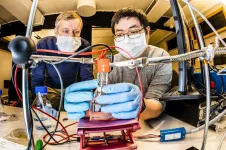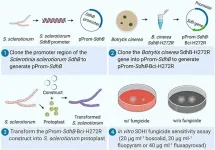To understand ecology, follow the connections
New research from UMass Amherst suggests that demography is the key to managing habitat loss and fragmentation
2021-07-06
(Press-News.org) AMHERST, Mass. - City sprawl and road development is increasingly fragmenting the habitats that many plant and animal species need to survive. Ecologists have long known than sustainable development requires attention to ecological connectivity - the ability to keep plant and wildlife populations intact and healthy, typically by preserving large tracts of land or creating habitat corridors for animals. New research from the University of Massachusetts Amherst argues that it's not enough for ecological modelling to focus on the landscape. If we want the best-possible ecological management, we should consider when and where individuals are located.
"Everybody needs a place to live," says Joseph Drake, a graduate student in the department of environmental conservation and the organismic and evolutionary biology program at UMass, and the lead author of the research that appeared recently in Ecography. "Humans build roads, but animals and plants have pathways. Movement along the pathways are essential to the continued persistence of plant and animal populations." This is where connectivity comes in, and there are two traditional ways of modelling it. One, the structural approach, focuses on where suitable habitats are and whether or not these habitats are contiguous, connected via corridors, or broken up and widespread. The other definition, functional connectivity, considers how species respond in relation to the habitats they move through.
But, says Drake, it's not enough to focus on either the structural or functional aspects of connectivity. Instead, a third aspect - demography - needs to be combined with the other two. "If we wish to understand how human activities influence plants and wildlife," says Drake, "then we need to know where the animals and plants actually are, where they want to be and how they move." Drake and his co-authors advocate for a "demographically weighted approach," which substantially improves the ability of ecological models to mirror observed reality. Indeed, the authors show that ignoring demography can markedly reduce the performance of ecological models, which has real-world implications for species' chances of survival.
Furthermore, the weighted approach is better not only at understanding populations of plants and animals as they are now, but in the future, as well. As plants and animals continue to adapt to climate change by moving across the landscape, understanding how species' dispersal affects their existence will take on growing importance.
INFORMATION:
Contacts: Joseph Drake, jdrake@umass.edu
Daegan Miller, drmiller@umass.edu
[Attachments] See images for this press release:

ELSE PRESS RELEASES FROM THIS DATE:
2021-07-06
DURHAM, N.C. -- Plant-based meat substitutes taste and chew remarkably similar to real beef, and the 13 items listed on their nutrition labels - vitamins, fats and protein -- make them seem essentially equivalent.
But a Duke University research team's deeper examination of the nutritional content of plant-based meat alternatives, using a sophisticated tool of the science known as 'metabolomics,' shows they're as different as plants and animals.
Meat-substitute manufacturers have gone to great lengths to make the plant-based product as meaty as possible, including adding leghemoglobin, an iron-carrying molecule from soy, and red beet, ...
2021-07-06
Terence D. Capellini has been interested in how joints work for almost three decades. Part of it is due to personal experience, having sustained several joint injuries as a college ice hockey player and recently developing knee osteoarthritis. But the principal investigator of Harvard's Developmental and Evolutionary Genetics Lab has also seen the pain and limited mobility of loved ones who've received similar diagnoses and injuries.
"We have all these joints in the body and they don't look the same from one another," said Capellini, the Richard B. Wolf Associate Professor in the Department of Human Evolutionary ...
2021-07-06
Pediatric melanoma is a rare disease with only around 400 cases diagnosed in the United States every year. To better understand this disease and how best to treat it, St. Jude Children's Research Hospital scientists created a registry called Molecular Analysis of Childhood MELanocytic Tumors (MACMEL). A paper on findings from the registry was published today in Cancer.
"What is different about the MACMEL registry is that it is prospective," said corresponding author Alberto Pappo, M.D., St. Jude Solid Tumor Division director. "We're seeing the vast majority of enrolled patients as part of the melanoma clinic at St. Jude. We can follow these patients and conduct detailed pathology and molecular analysis."
More ...
2021-07-06
University of California San Diego School of Medicine researchers have identified a possible link between inadequate exposure to ultraviolet-B (UVB) light from the sun and an increased risk of colorectal cancer, especially as people age.
Reporting in the journal BMC Public Health, researchers investigated global associations between levels of UVB light -- one of several types of ultraviolet light that reach the Earth's surface -- in 2017 and rates of colorectal cancer across several age groups in 186 countries in 2018.
Lower UVB exposure was significantly correlated with higher rates of colorectal ...
2021-07-06
Manufacturing - Powered by nature
A team of researchers at Oak Ridge National Laboratory demonstrated the ability to additively manufacture power poles from bioderived and recycled materials, which could more quickly restore electricity after natural disasters.
Using the Big Area Additive Manufacturing system, the team 3D printed a 55-foot pole designed as a closed cylindrical structure. They evaluated three different composite materials with glass fibers including cellulose ester, recycled polycarbonate and bamboo fiber reinforced polystyrene.
"We developed a modular design that is easy to manufacture, transport and assemble," ORNL's Halil Tekinalp said. "Sections within the pole can ...
2021-07-06
BOSTON - A skin pigmentation mechanism that can darken the color of human skin as a natural defense against ultraviolet (UV)-associated cancers has been discovered by scientists at Massachusetts General Hospital (MGH). Mediating the biological process is an enzyme, NNT, which plays a key role in the production of melanin (a pigment that protects the skin from harmful UV rays) and whose inhibition through a topical drug or ointment could potentially reduce the risk of skin cancers. The study was published online in Cell.
"Skin pigmentation and its regulation are critically important because pigments confer major protection against UV-related cancers ...
2021-07-06
A transplant of healthy gut microbes followed by fibre supplements benefits patients with severe obesity and metabolic syndrome, according to University of Alberta clinical trial findings published today in Nature Medicine.
Patients who were given a single-dose oral fecal microbial transplant followed by a daily fibre supplement were found to have better insulin sensitivity and higher levels of beneficial microbes in their gut at the end of the six-week trial. Improved insulin sensitivity allows the body to use glucose more effectively, reducing blood sugar.
"They were much more metabolically healthy," said principal investigator Karen Madsen, professor of medicine in the Faculty of Medicine ...
2021-07-06
Researchers at Linköping University have developed a method that may lead to new types of displays based on structural colours. The discovery opens the way to cheap and energy-efficient colour displays and electronic labels. The study has been published in the scientific journal Advanced Materials.
We usually think of colours as created by pigments, which absorb light at certain wavelengths such that we perceive colour from other wavelengths that are scattered and reach our eyes. That's why leaves, for example, are green and tomatoes red. But colours can be created ...
2021-07-06
Succinate dehydrogenase inhibitors (SDHIs) are a class of fungicides widely used to control many fungal diseases of crops. The relationship between SDHIs and fungi can be compared to finding the right key for the right lock. However, fungi are adaptable and develop resistance to fungicides often by changing the lock so that the SDHI is no longer able to open the door. Because of this adaptability, it is important to understand the biological mechanisms of fungicide resistance.
A recent collaboration between scientists in Michigan and Massachusetts as ...
2021-07-06
However, the majority of these organisms are believed to be in a state a state of 'dormancy' due to environmental stress, such as nutrient-poor conditions. An international team of scientists led by Dagmar Woebken and Stephanie A. Eichorst from the University of Vienna investigated how acidobacteria, which are widespread in soils, can survive under adverse conditions. Two recent studies published in The ISME Journal and mSystems describe these survival strategies.
The living conditions that microorganisms encounter in soils are unpredictable and challenging. Nutrients and oxygen are frequently scarce for long periods. Acidobacteria manage to defy these extreme conditions. They are found in an astonishing diversity in soils worldwide. "Since they are this widespread, ...
LAST 30 PRESS RELEASES:
[Press-News.org] To understand ecology, follow the connections
New research from UMass Amherst suggests that demography is the key to managing habitat loss and fragmentation




